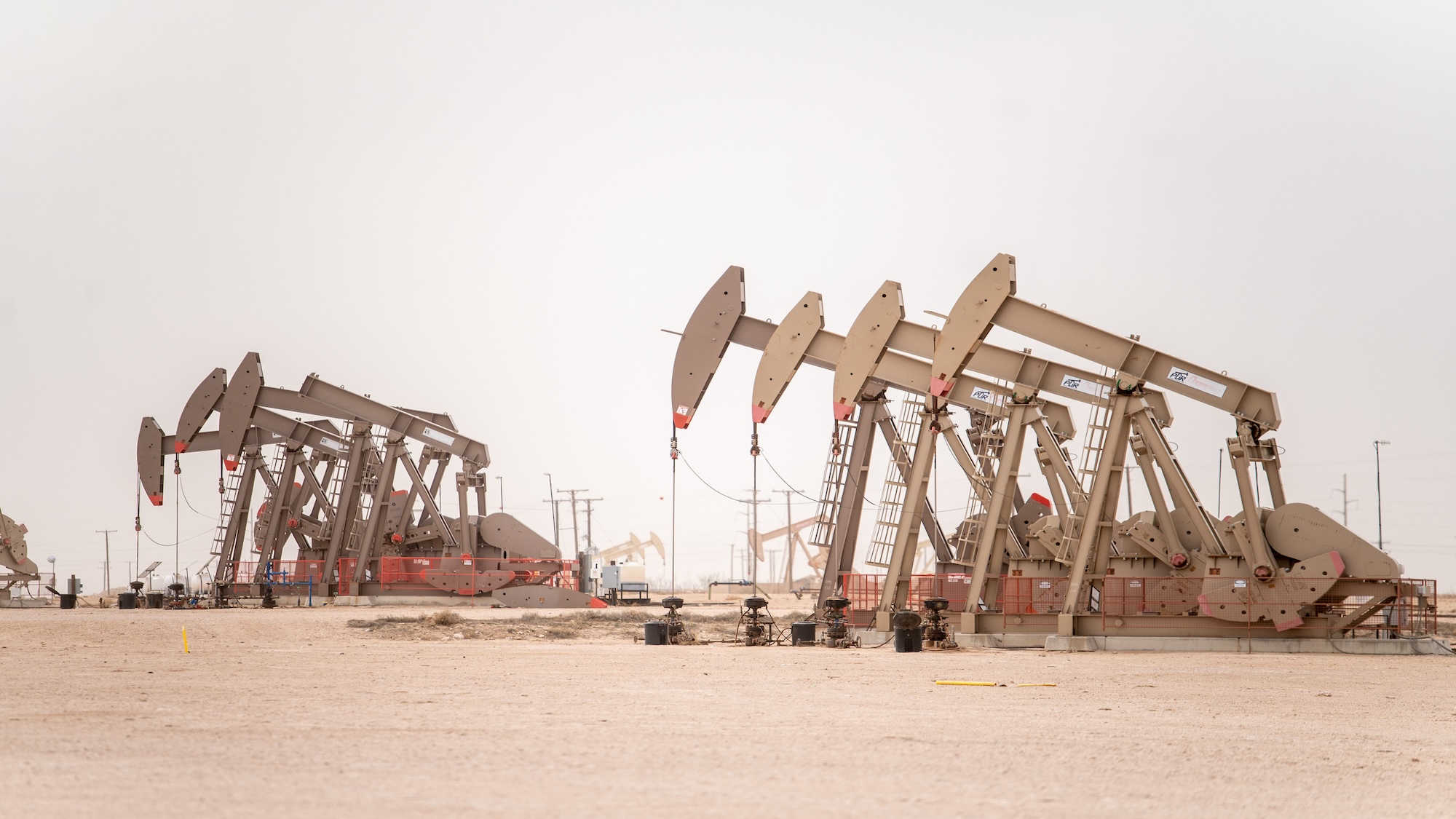Oil price posts two-year highs - but how long can it last?
Brent rose above $59 a barrel this week, its best third-quarter showing since 2004

Oil price potential 'limited' as Opec power wanes
1 June
On the eve of a meeting of the Opec cartel that is unlikely to yield any collective accord on supply, more analysts are speculating that the oil price has "only limited potential" for further gains this year.
A Reuters poll yesterday found "most traders expect only limited potential for further price gains this year as global oversupply persists". This came a day after the Wall Street Journal's monthly survey of investment bank brokers recorded price forecasts that imply stagnation and even modest declines in the coming months.
The Week
Escape your echo chamber. Get the facts behind the news, plus analysis from multiple perspectives.

Sign up for The Week's Free Newsletters
From our morning news briefing to a weekly Good News Newsletter, get the best of The Week delivered directly to your inbox.
From our morning news briefing to a weekly Good News Newsletter, get the best of The Week delivered directly to your inbox.
International price benchmark Brent crude retreated from close to its $50 high for this year overnight and this morning. It was down close to two per cent and below $49 a barrel at around 10.30am in London. US counterpart West Texas Intermediate dropped 1.6 per cent to $48.32 a barrel.
Recent price trends have been driven by supply disruption in Canada, Nigeria, Iraq and elsewhere - and subsequent speculation that, in Canada at least, issues might be resolved faster than expected.
But the latest negative move is based on the underlying supply excess that has been dragging the market lower for two years. Specifically, there is anecdotal evidence ahead of the Opec meeting in Vienna tomorrow that its biggest producer members might be preparing to take more unilateral action to boost their own exports.
Iran's representative told Reuters that Tehran would not commit to any oil output freeze as it returns from international sanctions, while The Times reports that the new Saudi Arabian oil minister, Khalid al-Falih, held a 90-minute meeting with the head of Opec, Abdullah al-Badri, yesterday during which it is believed he prepared the ground for his country continuing its turf war.
A free daily email with the biggest news stories of the day – and the best features from TheWeek.com
Elsewhere in the region, Iraq was said earlier this week to be preparing to release an additional five million barrels of oil in June on top of record daily output. The Times cites claims that such rises could even be a ploy to set the bar higher for any eventual cut to supplies agreed at a future Opec meeting, nullifying the potential effect.
"The effective demise of Opec as we have known it continues," Malcolm Graham-Wood, of Hydrocarbon Capital, said.
Oil price forecasts rise (but we're still going nowhere fast)
31 May
In what is a seen as a boon for big Middle Eastern-producer countries ahead of Thursday's meeting of the Opec cartel, oil price forecasts are heading north.
A monthly poll of investment bank brokers by the Wall Street Journal has recorded an increase in forward-looking price projections for the third successive month. Bankers now predict Brent crude will average $43 a barrel in 2016, up $2 from the April survey, while its US counterpart, West Texas Intermediate, will average $41, up $1.
The WSJ adds that the findings will ease pressure on Opec members, especially the likes of Saudi Arabia and Iran, who are seeking to increase output despite a global supply overhang that has been dragging on prices for two years. Calls from within the cartel for production restraint to support higher prices have been growing in recent months.
"The market is conspiring to help Opec," said Doug King, the chief investment officer at RCMA Asset Management and the manager of a $240m commodity hedge fund. "If I was in the Saudis' shoes right now, I'd be pretty happy."
But the increased forecasts still make for a fairly bearish view on the medium-term price trend. Latest estimates assume oil will still be below $50 by the end of this year and that Brent will trade at $43 a barrel, below its current level, in the third quarter.
At shortly after 10am in London today, the international benchmark was down 0.8 per cent at $49.37 a barrel. WTI was up marginally and trading at a premium, at $49.44 a barrel.
US prices are being supported by the start of driving season, when demand peaks, on the back of last week's big draw on crude stockpiles. Global prices were conversely being dragged lower, again, by news that Middle Eastern supplies are set to surge.
"Iraq will supply five million barrels of extra crude to its partners in June," industry sources told Reuters, on top of a target for "record crude export volumes from southern terminals next month of 3.47 million barrels per day". Saudi Arabia and Iran are both also seeking to boost exports in an escalation of a production turf war.
Has oil hit a 'sweet spot' for the global economy?
27 May
In the end, the rise above $50 a barrel for oil did not last long.
It was a significant milestone that the ongoing rally had built up enough steam to get over the psychologically important threshold this week.
But concerns over supply still worry investors and international benchmark Brent crude, having hit a new 2016 intraday high of more than $50.50 a barrel yesterday, fell back to a little more than $49 a barrel in London this morning.
"The global surplus still exists and there is still a possibility that oil prices could retrace further," Dominick Chirichella, a senior partner at the Energy Management Institute in New York, told Reuters.
Jim Ritterbusch, of Chicago-based oil markets consultancy Ritterbusch & Associates, said: "We are viewing current risk/reward ratios as unfavorable toward new longs [bets on higher prices] at current levels." He cites a potential drop of Brent to $47.50.
In truth, prices have been caught in a narrow range of $48 to $50 for the past two weeks. Production outages in Nigeria, Canada and Iraq have boosted a more bullish view of the global oversupply situation, but pledges by Saudi Arabia and Iran that they will continue to ramp up output offer a bearish counterweight.
Perhaps more pertinently, there are those who believe the break above $50 could encourage more drilling, especially in the US shale sector, and that this will eventually send prices spiralling down again.
An alternative view is that current prices are something of a "Goldilocks" scenario, says the Wall Street Journal, with $50 oil a "sweet spot for the global economy". It believes this level provides enough succour for producer nations and companies, without encouraging renewed supply, and is sufficiently low to boost the global economy.
"Prices in the $50 to $60 range would be high enough to ease some of the pressure on producers, while still low enough to boost spending on other goods and services," Julian Jessop, the chief global economist at Capital Economics, said.
The WSJ adds that $50 oil could be a "red herring" and that the real price level to watch out for is between $60 and $65.
If current trends persist, says Citigroup, there is a chance this could be possible by the end of next year.
Oil price hits $50 a barrel – could it now go on to $55, $60 or $65?
26 May
For the first time this year, oil has broken the $50 level – and had stayed a shade above the psychologically important threshold at around 10am in London trading this morning.
Brent crude touched as high as $50.13 a barrel in the overnight Asian session before pulling back slightly. Its US counterpart, West Texas Intermediate, was 0.6 per cent higher this morning, to within 40 cents of the $50 barrier.
Spurring this latest upswing was data yesterday from the US Energy Information Administration, which confirmed a big draw on US crude oil stocks last week as global supply outages hit imports. The watchdog reckons previously record reserves fell by around 4.2 million barrels, reports the Financial Times.
A number of pipelines in Nigeria have been affected by sabotage attacks, while the effects of wildfires are still being felt in Canada and bad weather and power outages, among other issues, has seen production in Iraq fall from record levels earlier this year.
Now oil has finally broken through $50 – after flirting with the threshold for two weeks – there is growing confidence that a steady price rally might be sustained through to the end of 2017.
Energy giant BP has revised up its price assumption for next year to between $50 and $55, says the BBC, while earlier this month, previously bearish Goldman Sachs brokers said prices should remain around $50 for the rest of this year and rise to $60 a barrel by the end of next.
Citigroup analysts have gone further and said crude stocks could fall for a concerted period and that prices could be as high as $65 a barrel by the end of 2017.
There remains a high degree of caution in these estimates, however. Citi, for example, told the Wall Street Journal it has only "65 per cent or so confidence in this price path" as it is concerned by the prospect of new production coming online as prices rise from $50 to $60. It reckons as much as 400,000 of shale oil output in the US could return to the market.
Indeed, the FT notes that Pioneer Natural Resources, a leading independent producer, said last month that it would add drilling rigs if the oil price was above $50 in 2017 and inventories were declining.
Oil price hits seven-month high – will it break $50?
25 May
The oil price broke out of a four-session mini-slump overnight and was hovering close to seven-month highs this morning after a positive report on supply boosted sentiment.
US benchmark West Texas Intermediate jumped 2.5 per cent to $49.27 a barrel in afternoon trading in New York yesterday, a new 2016 peak and the highest price since October. It was holding within 10 cents of this at around 9.45am in London this morning.
International benchmark Brent crude peaked last night at around $49.24, around 25 cents below its six-month high of last Monday, and was similarly steady in early London trading.
This latest rebound was driven by a report from the American Petroleum Institute, which the Financial Times notes estimated a 5.1 million barrel fall in US crude oil reserves last week. Official figures are published later today and the API numbers have been known to be well out of kilter with these on occasion, but the report is still another bullish short-term supply indicator.
Oil slumped over the past two years because of entrenched oversupply but has rallied strongly since February on hopes for output restraint and has been bolstered again by unplanned production outages in Canada, Nigeria and elsewhere that even bearish analysts reckon should temporarily rebalance the market.
The Financial Times says the positive supply picture was enhanced yesterday by a report from Opec member Iraq that revealed production had fallen from record levels to 4.5 million barrels a day last month, because of "maintenance, bad weather and power outages".
Whether or not the oil price will decisively advance and sustainably break the psychologically important $50 barrel barrier remains to be seen.
Opec members such as Qatar have called for a deal at the next meeting of the cartel next week. However, its two most influential producers, Saudi Arabia and Iran, have indicated they will continue to ramp up exports. As supply outages are resolved, this could quickly reinstate a supply excess in the coming months at a time when the overhang of global crude stocks is at an all-time high.
Added to that are the predictions that any break above $50 would bring back online a mass of US shale production that has found a break-even around this level, which the FT argues could "cap further price gains".
-
 Why it’s important to shop around for a mortgage and what to look for
Why it’s important to shop around for a mortgage and what to look forThe Explainer You can save big by comparing different mortgage offers
-
 4 ways to save on rising health care costs
4 ways to save on rising health care costsThe Explainer Health care expenses are part of an overall increase in the cost of living for Americans
-
 How to financially prepare for divorce
How to financially prepare for divorceThe Explainer Facing ‘irreconcilable differences’ does not have to be financially devastating
-
 How might the Israel-Hamas war affect the global economy?
How might the Israel-Hamas war affect the global economy?Today's Big Question Regional escalation could send oil prices and inflation sky-high, sparking a worldwide recession
-
 Recent mega-mergers could signal a turning point for the US oil industry
Recent mega-mergers could signal a turning point for the US oil industryTalking Point Both Chevron and Exxon have recently spent billions to acquire smaller oil companies
-
 Has Saudi Arabia lost control of oil prices?
Has Saudi Arabia lost control of oil prices?Today's Big Question Kingdom goes it alone to cut production, risking tension with US and reigniting cooling inflation in Europe
-
 US angered by Opec+ oil cut
US angered by Opec+ oil cutSpeed Read Energy prices to rise further as producers slash supply by two million barrels a day
-
 Global oil demand forecast lowered for 2020 and 2021
Global oil demand forecast lowered for 2020 and 2021Speed Read IEA report says jet fuel demand remains the major source of weakness
-
 Are US-Iran tensions flaring again?
Are US-Iran tensions flaring again?In Depth Trump threatens military action over Twitter
-
 Can a deal be struck to raise oil prices?
Can a deal be struck to raise oil prices?In Depth Opec+ will convene today over video link in a bid to boost crude
-
 What do negative oil prices mean?
What do negative oil prices mean?In Depth Perfect storm of oversupply and storage shortages sees producers paying to get rid of US crude